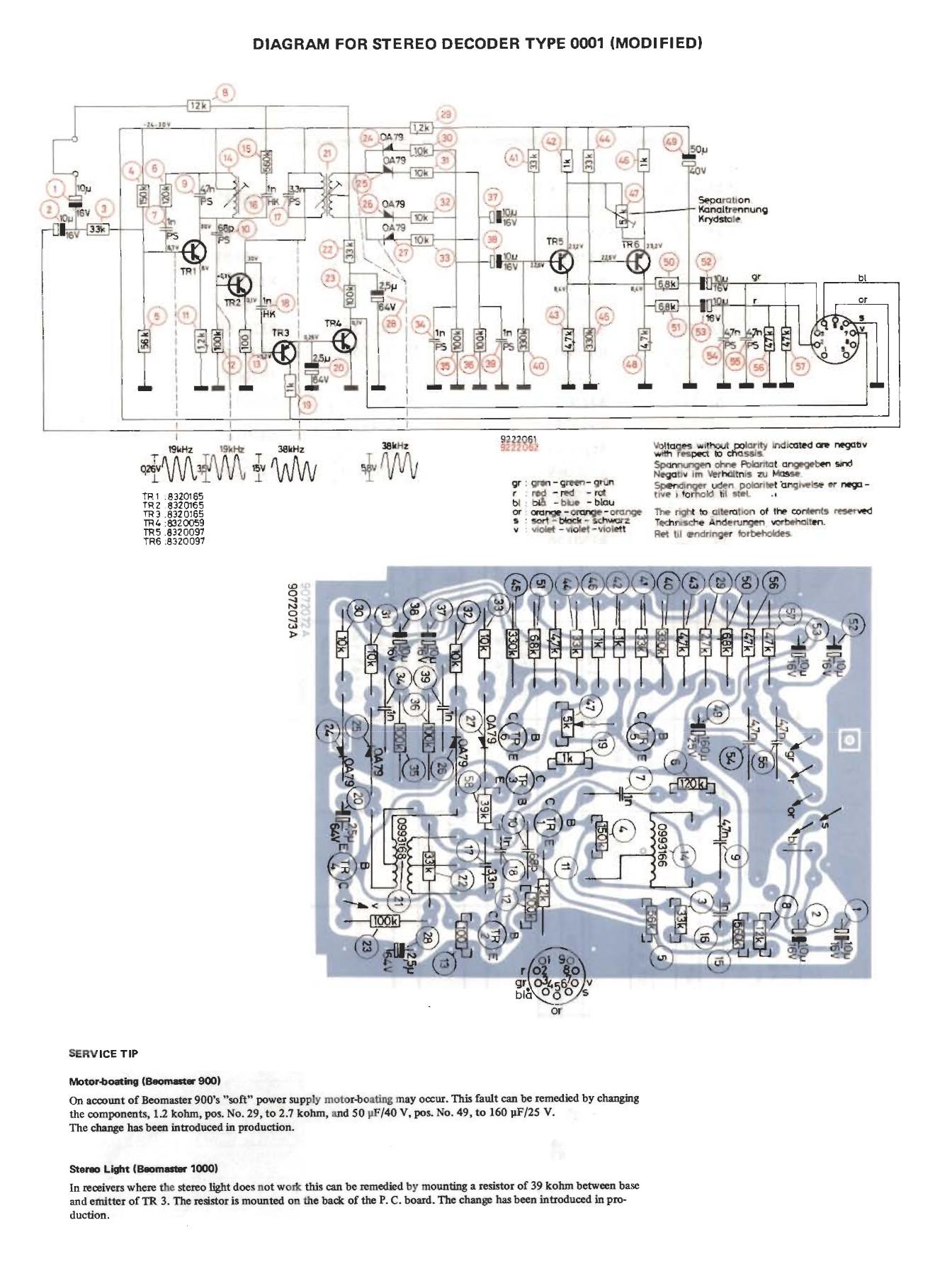Forum Replies Created
-
AuthorPosts
-
HatOfTheCat
BRONZE MemberPS When I received the receiver it had its transformer wired for 220v. The receiver coped with that even though that means it must have been pumping out approx. 2v above the 29.5v it is now. I swapped the connection points for 240v and spun the little disc in the window on back panel to match. This does make me think that the “black key” transformer might be useable though might be best to turn down the regulator first a bit before fine tuning it.
HatOfTheCat
BRONZE MemberWell after using the later version 0001 decoder board happily for 2 months it then decided to stop switching on the STEREO lamp, decodes okay but the circuit part on the board that triggers the lamp has failed somehow. The 38kHz signal is strong and correct just before it. Have spent quite some time trying to get it working again… various new parts (there aren’t many in this part of the circuit and I think I’ve changed them all) but no joy. So I turned back to the original decoder board and installed that, it has all new replacement capacitors and transistors, a quick tweak of the two cores as per the schematic I posted to get the max level for the 38kHz signal at test point and it WORKS !! So I now have a fully original Beomaster 1000 Type 2301 with early model decoder board (as used in a Beomaster 900 too)… and a spare “broken” later board …I’ve put fixing that on the back burner.
HatOfTheCat
BRONZE MemberFIXED AND WORKING
Was nothing wrong with the IF stage, it was just the decoder board that was not working properly.
I recapped the decoder board I have from a later Type 2317 and swapped that in (it had several obviously leaking caps). No adjustments made.
I’ll leave fixing the original board for a rainy day (just needs transistors replacing and likely a recap too).
HatOfTheCat
BRONZE MemberI’m certainly not going to dive into attempting an alignment Martin as I have neither the skills nor equipment to do one. However just to confirm, would need for alignment not have other symptoms such as poor reception etc ?? The radio sound is crystal clear with no distortion at all and stations are easily found and tuned in. The tracking may be slightly out on the dial (less than 0.5Mhz) but that’s it. Below is clearest schematic I’ve found for the decoder board that I have (mine does look to have the resistor mod for Beomaster 1000 that it notes in paragraph at the bottom).
I’ve only had 30 minutes today to look at this problem. First I double checked with two channel scope that the receiver is only putting out mono sound from FM, confirmed that. I’ve checked those transistors (hard to see the labelling as they are in between larger components) and I could only see AF126 type and none of the AF116/AF117 ones so that’s good. I also checked the MONO switch isn’t simply stuck on internally and it looks like it is definitely off (it is faulty and doesn’t latch but it doesn’t seem to go on at all as gummed up inside). I’ve also checked the 4 germanium diodes on the decoder board as apparently they are of a type that can fail but all checked ok, about 0.4v as they should be. I also had a look at pin 7 on the connector (violet wire) as that is the one connected to the stereo indicator lamp and collector of TR4 which switches it on, was -28v as long as FM selected but didn’t change when moving tuning and near to zero when any other source selected.
1 August 2024 at 18:00 in reply to: Beomaster 1000 – white key version with Danish tuning dial #57880HatOfTheCat
BRONZE MemberStroke of luck. The original serial number label with type number was wedged under the edge of the schematics envelope.
So its a Type 2301
Attachments:
You must be logged in to view attached files.HatOfTheCat
BRONZE MemberFIXED – cracked solder joint on emitter of the TR22 output transistor (BD697 type). The heat sink on this model is held onto the metal frame of the case by just two screws, one at each end of which the one at the left end was missing (the end where the TR22 is right by). The output transistors are held in place each with a screw that goes through the heat sink, through the transistor and into a brass threaded insert on a bar on the inside that spans them all effectively sandwiching them to the heatsink (bit overkill). So any movement in the heatsink will push on the transistors and flex their solder joints to the PCB. I didn’t see it until I started looking at how to remove the heatsink then saw it wasn’t fully attached. Moving it a little made the crack in the solder open enough to see (under the layer of dust, I should have cleaned it before starting work as I did have a look at the joints first off). Reflowed it and the others for that transistor and inspected the others and hey presto left channel working 🙂 Annoyingly reflowing all the output transistor joints was first thing I did trying to fix the last one, but I thought “hey there’s a massive bar thing holding them firmly… they won’t have been moved about”.
26 March 2024 at 14:54 in reply to: Beomaster 901 stereo light not working – FIXED was weak FM aerial signal #53798HatOfTheCat
BRONZE MemberThanks for your reply Dillen Problem fixed !! 🙂
First thanks for confirming that the Stereo green light should ONLY come on with a stereo station (NOT with other sources, I was misled by another old thread into thinking it would). I read through the service manual again and in the “Decoder” section it explains that when the FM signal is weak then it will not produce stereo but only mono, see text below. This explains the voltages not changing at 2TR10 even though I had an FM station tuned in. I have been working on the receiver a long way from FM aerial outlet with many metres of an old aerial cable between it and the receiver… so I moved the receiver closer and with a new short cable and also cleaned the aerial input, now the FM signal is strong (can pick up several extra stations) and green light comes on ! So it was all working as it should but the poor signal received just meant no stereo decoding was happening. Now I understand much better how this part of the receiver works, so not entirely time wasted. Now I just need to adjust the tuning indicator lights, as per service manual, as they are a little out of balance and all will be done on this Beomaster 901.
“During reception of very weak FM signals the base of 2TR15 will obtain no signal, with the result that the transistor will draw no current. Maximum voltage will be present at the collector, and this voltage is applied to the emitter of 2TR9, cutting off that transistor. This will cause the receiver to reproduce the weak stereo signal as mono signal”
25 March 2024 at 21:58 in reply to: Beomaster 901 stereo light not working – FIXED was weak FM aerial signal #53794HatOfTheCat
BRONZE MemberUpdate.
“2C56 capacitor was originally a tantalum one?” – yes, I got a service kit from Beoparts and replaced ALL the tantalum ones except two 4.7uF ones that I couldn’t easily access as they are under the volume capstan.
“What was the original TR10 reference?” – its a SPS 5418, the service manual lists this and MPSA 13 as possibles.
I removed TR10 from the board and it made no difference at all to the voltages measured at contact points for B,C & E 🙁 The transistor looks fine and not shorted B to E, see also attached pic from component tester. I measure resistance across 2C56 and was about 45k in board, so I think that is ok.
I also removed TR11 and TR12 (both BC407B) from board and tested them, both are ok.
I’ve reinstalled TR10, TR11 and TR12.
Looking wider around the board I did get some voltages around TR9 (B=1.6v,C=16.5v,E=1.8v) which look a little high versus spec (?). Also I looked for voltages at other points, at +ve side of 2D11 & 2D12 found 0v and was zero right through everything from there to base of TR11.
I’m trying to work out what to check next ??
24 March 2024 at 21:30 in reply to: Beomaster 901 stereo light not working – FIXED was weak FM aerial signal #53792HatOfTheCat
BRONZE Member“if you have 0v at the base then the light is not turned on. have you tried to remove the transistor and measure the base voltage again (to see if the transistor is not base/emitter shorted) you can even measure 2C56 is this cap is not shorted/or has low impedance compared to the 33K resistor. Especially since it seems to be tantalum”
Yup, pulling it was my default next step, was just trying to see if there was a common known other cause for the lamp fault before diving in. Its the same MPSA13 type transistor that I think was root cause of failure that cascaded through the power amp stage transistors so I am suspicious of it anyway. Have a few new ones in packet so it will get pulled and tested. BTW the recap also included the tantalum ones including 2C56 (yellow ones in the photo of board, the blue ones are some of the many many many original orange electrolytics… they looked super cool but a couple even had visibly cracked cases).
-
AuthorPosts

